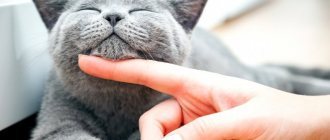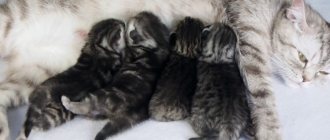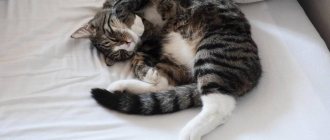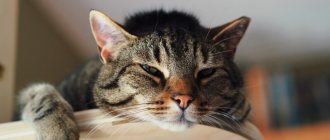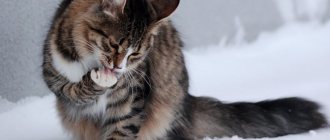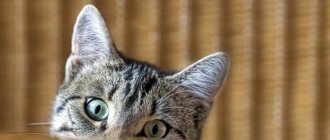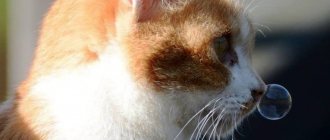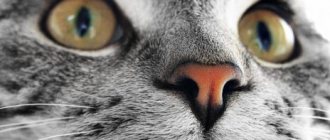People who have ever had a cat know what purring sounds like. This is often taken for granted. A person associates such “music” with a satisfied and well-fed cat. However, only a few know how this sound is formed and why the animal makes it.
- 1.1 Purring and rumbling
1.1.1 Video: how a cat growls
- 2 How does purring affect a cat’s body?
2.1 Video: purring - a lullaby for a kitten
Which organs are responsible for a cat's rumbling?
Sometimes you may come across the statement that if a cat purrs, it does so either through its nose or through its throat. This is not entirely true: the brain is the main organ that causes cats to purr. Of course, the sounds themselves are produced by the vocal cords, which vibrate due to the movement of the vocal muscles located in the larynx. However, without a corresponding signal from the brain, the muscles will not begin to move on their own. That's why cats never rumble or purr for no reason; there must be something that spurs their brain to reproduce the command to “sing,” for example, seeing a sparrow outside the window or inhaling the aroma of fried fish.
Why do cats purr?
The issue of cats purring is much more complex and deeper than it seems at first glance. Understanding why your pet purrs will be a big step towards predicting his mood, meeting his needs and, above all, living a harmonious life with him. Below are some of the reasons why cats purr.
Reason #1: Purring as a means of communication
Cats communicate primarily through movement, but that doesn't mean they can't communicate through sounds. However, unlike humans, whose speech has evolved over many years, cats have to make do with just a few sounds they can produce - and purring is one of them.
One of the reasons your pet purrs is communication.
Did you know that cats can make many different purring sounds? For example, if your pet purrs due to hunger, then the purring is accompanied by a whimper, similar to the cry of a child. Sounds like these are hard to ignore
The idea is to appeal to the parental instinct in you and draw attention to the hungry animal
Reason #2: the bond between a mother and her kittens
A nursing mother is known to purr to communicate with her kittens. She uses purring as a lullaby to calm babies. This works much the same way as rocking or humming for babies.
Babies communicate with their mother by purring
Kittens begin to purr a few days after birth. At this time, their auditory and visual abilities are not yet fully functional. For young kittens, purring is a way of reassuring their mother that they are okay. Babies also purr to call out to their mother when they feel she is not around.
Reason #3: Manifesting Happiness and Satisfaction
A cat purrs when it is happy and content. This is due to her good health and satiety. A cat will purr while eating, and kittens will purr when their mother licks them. Tickling or a light massage also makes cats purr with pleasure.
A cat purrs when it is happy and content
These manifestations of feline pleasure can make us, their owners, happier. Cat purring is in the frequency range that relaxes people. It has been scientifically proven that cat caresses and purring vibrations have a calming effect on humans. Reducing tension correspondingly lowers blood pressure levels. This explains the benefits of cat companionship for your health.
Reason #4: Pain relief
Do you think cats only purr when they are happy and healthy? It is not always so. You should not ignore the signals that your pet gives, because the cause of purring may be illness. Purring can also be caused by your cat trying to relieve your pain.
Cats purr when they seek relief from pain.
- Cats tend to purr during labor. Purring triggers the release of endorphins in the animal's brain centers. This “happy hormone” acts as a powerful natural pain reliever and helps her relax. Purring is also an alternative to the agonizing screams that would attract predators in the wild.
- In addition, cats can purr in a range that helps speed up the healing of fractures and torn ligaments. These frequencies can also soothe sore muscles. The need for such skills is due to the fact that these animals sleep on average 16 hours a day. This prolonged inactivity contributes to decreased bone density and muscle strength. Seals counteract these processes by purring. This can also speed up a person’s healing. The purring frequencies are believed to be in the same range as the frequencies used in ultrasound devices to speed the healing of bone fractures in humans.
- If you have trouble breathing, try to breathe in sync with your cat's purring. The purring process imitates the normal dynamics of human breathing - thus the cat helps restore the normal rhythm of inhalation and exhalation.
However, don't try to imitate your cat's purring. If you have tried this before, then you must have already realized that it is impossible. You probably experienced shortness of breath after the first few seconds of trying in vain. The question arises: how do cats do this?
Rumbling is a sign of peace and more
Many of us believe that since a cat purrs, then everything is fine. But, unfortunately, such uterine sounds are not always a sign of pleasure or satiety. Let's see in what cases you can hear a cat purring:
Photo: Scottish Fold kitten | Dreamstime.com
- Possessive rumbling
- if a cat tramples with its front paws and purrs, then one can suspect that this is how the animal marks the owner in a unique way, making it clear to the person that the head of the house is His Majesty the Cat; - Rumbling as a sign of pleasure from communicating with a person
- almost all cats purr when they are petted, but suddenly stop doing this when they get tired of the owner’s touch; - Purring as an attempt to help oneself
- sometimes a cat purrs like a tractor if something hurts. So, a pet may well purr, licking its wounds after a collision with a neighbor’s dog. A cat can purr during a fracture caused by a fall from a height, during childbirth, or during an exacerbation of any chronic illness. It's sad, but sometimes animals purr even before they die, perhaps trying to calm themselves down; - Rumbling as a signal of calm for kittens
- if you watch a nursing mother and her cubs, you will notice that the cat moves her paws and purrs when the kittens suckle her milk. Rumbling at such moments is necessary for babies to feel safe; - Rumbling as a sign of a peaceful attitude
- sometimes cats can purr in front of each other. They do this in order to demonstrate goodwill to other individuals; - Rumbling as an accompaniment to sweet slumber
- cats cannot purr in their sleep, but during rest and slumber they can purr quite well. Especially in situations where a delicious lunch has been eaten and there is no threat around; - Rumbling as an anticipation of something good
- our pets begin to rumble when they anticipate that something pleasant or tasty is waiting for them. So, a cat can easily start “singing” loudly if he sees that the owner is sitting down in a chair (it’s time not just to watch TV, but also to pet the cat!). Or you can hear the purring of an animal that has seen and felt that the owner has begun to cut up fish or meat in the kitchen; - Rumbling as an attempt to cure the owner
- many owners know that cats can predict a person’s mood, and also feel when a person is not feeling well. For example, if a cat owner has a heartache, then the pet can easily lie down on the cat’s chest and begin to purr and rumble. This is how the animal tries to help the owner cope with pain.
So, there are many reasons for a cat’s purring. But how can you recognize when an animal makes such sounds from pleasure and when from pain? It turns out that cats always purr in different ways. Thus, a loud rumbling at a frequency of about 50 Hz may indicate that the pussy is trying to cope with the pain of a fracture or dislocation, and a rumbling at a frequency of 100 Hz or more may indicate that the animal is suffering from some kind of chronic disease.
In addition, the vigilant owner will be able to notice the state of ill health by other alarming symptoms in addition to loud rumbling: elevated temperature, upset stool, vomiting, limping, and so on. And if an animal purrs quietly at a low frequency of up to 35 Hz, closing its eyes and tucking its paws under itself, then it is probably in calmness and in a good mood.
How does purring affect a cat's body?
Sometimes a healthy cat purrs next to a sick one, and this happens for a reason. From the outside it may seem that a purring cat is happy with the presence of a relative, but British scientists have proposed a version of purr therapy. Firstly, the monotonous sound is soothing. Secondly, the vibration produced by purring is similar to a massage. In this case, we are talking about a therapeutic effect on internal organs. In addition, purring increases the cat's vitality and improves its mood.
By purring, a cat can “treat” not only itself, but also its relatives
Indeed, if you watch a cat, you can see how it licks its wound and purrs. Saliva has a disinfecting effect, and purring acts as an ultrasound and anti-stress. Purring cats are healthier, calmer and friendlier.
Video: purring - a lullaby for a kitten
Cat purring - real sound therapy
We have already mentioned that cats often lie down on the owner’s sore spot and begin to purr. An animal can, for example, lie on the owner’s legs if they are “whining” about the weather. Or even lie on your head when the owner is tormented by a migraine. What does this mean, can pets really heal? It turns out that the purring of cats is therapeutic sound therapy.
Photo: Scottish Fold kitten | Dreamstime.com
A measured, quiet sound calms frayed nerves no worse than the sound of rain or the sound of a babbling stream. Felinologists believe that cats, with the help of special rumbling sounds, can treat the following ailments:
- Bone fractures, joint and muscle pain;
- Nervous disorders (depression, stress);
- Reduced immunity;
- Arterial hypertension;
- Diseases of the heart and blood vessels;
- Various inflammatory processes;
- Diseases of the stomach and/or intestines;
- Respiratory ailments.
Even though the sounds of rumbling help relieve, for example, joint pain or lower blood pressure, such sound therapy cannot be considered a full-fledged treatment; you will still need the help of a doctor. However, a cat's purring fights well against the same fatigue and nervousness.
What to do if your cat stops purring?
There are no cats in the world that cannot purr.
Even lions, cheetahs, leopards and other impressive members of the cat family can purr and do it with pleasure. An exception applies to those animals that were born with defects in the development of the respiratory tract or received injuries that affected the breathing process. If your cat has stopped purring, something may be bothering her. Before you worry and take your pet to the vet, observe him carefully. Perhaps your pet is tired of your company and purrs when alone. This behavior is often observed in cats that do not have a private place to rest.
A cat may not purr or purr very rarely if it is kept in very comfortable conditions. Evolution has taught four-legged animals to use energy wisely, and meowing and purring are energy expenditures. Wild cats sleep most of the day and are only active when hunting. However, every living creature needs physical activity to maintain muscle tone and metabolism.
Long-term observation of wild cats revealed an unexpected fact. A cat can use monotonous, quiet purring as light exercise. It turns out that the cat is active, but spends a minimum of energy.
Do cats purr if they feel bad?
Not many owners know that cats purr to relieve stress or pain. Quadrupeds purr in the last minutes of their lives to make them easier to care for. There is a catchphrase: “Cats come and go from life to the sound of purring...”.
The purring of cats has attracted the attention of scientists for many years. Research has revealed that the sound range of a cat's purring ranges from 25 to 100 Hz.
These frequencies promote bone healing, relieve muscle pain and reduce stress.
Tests were carried out on humans. Results from control groups of people treated with cat purring proved that low-frequency ultrasounds significantly accelerated the healing of bone fractures. Purring high frequencies helped people calm down, reduce muscle pain and blood pressure.
Big cats purr too
So, cats purr for many reasons. Can their large wild counterparts make similar sounds? Or is rumbling a privilege only for domestic cats? The answer is: wild cats can also purr: lions and tigers, leopards and pumas, lynxes, jaguars and other representatives of the cat family. However, it is important to note that the larger the cat, the louder and more menacing its purring sounds, since the cartilage of their larynx is too hard to reproduce such measured sounds that an ordinary cat is capable of “singing.” For example, in the same lions, the peaceful rumbling sounds more like a roar.
Why do cats purr?
Purring is a rhythmic sound made by a cat. It can be continuous and/or vibrating. Pets purr on different occasions. Most often this happens at the moment of receiving positive emotions, when they are in a good mood or as a sign of gratitude (for example, for food or affection). The reason for purring may also be related to the pet’s character.
People are accustomed to the fact that cats purr, but wild representatives of the cat family - tigers, pumas, leopards, cheetahs, jaguars - can also do this.
My Hosya can come to her arms and purr. She pokes her head into your hand, demanding to be petted. Gradually the purring becomes quieter, the cat sighs and falls asleep. So I understand that she asked for affection. And sometimes, when I come after a long absence, she walks in circles near her legs, arching her back, and purrs loudly, and sometimes intermittently “squeaking.” When I take off my shoes, she takes off and runs to the kitchen - this is how she shows her joy and waits for a treat.
In fact, the reason for purring is not entirely clear. Scientists have not yet reached a consensus on this issue. Sometimes animals purr when left alone, when they feel safe or when they are eating. The female can purr during childbirth, and the kittens can purr already on the second day after birth.
There is also a theory that this happens for the purpose of self-medication: while the animal’s brain is purring, it produces a special hormone that has a healing and relaxing effect, which is why some cats purr when they are in pain (wounded cats).
Scientists have found that the nature of these sounds depends on the cause - purring can be grateful, calm, impatient, etc.
Due to the fact that pets sleep up to 18 hours a day, their musculoskeletal system weakens. This negatively affects bone strength. Scientists at the University of California suggest that the vibrating sound strengthens the animal's bones. Based on this theory, it was proposed to use a rhythmic sound of 25 hertz to treat the musculoskeletal system of astronauts, because they spend a long time in weightlessness, which is akin to a long stay without movement.
An adult cat may purr when interacting with kittens - this indicates that she is happy, calm and takes care of her offspring with pleasure. In addition, the animal may purr if it asks for something, for example, to open a window or door, of course, hoping that this request will be granted. The reason for purring can be anything. Just as a person cries and laughs out of happiness or fear, so a cat expresses different emotions when it purrs.
Purring and rumbling
Until the 20th century, felines were unofficially divided into purring, growling, etc. The difference in timbre and character of sound depends on the structure of the hyoid bone (it is structured differently in all species). The conditional division took place in groups. For example, tigers, lions, etc. were classified as roarers. But later it became clear that there were too many exceptions in each group (for example, snow leopards purr), and such a division was abandoned.
Snow leopards, despite their menacing nature, can purr
Cat growling can be caused by aggression or fear. Cats growl more often - cats do not have to defend their territory so fiercely. And since the growl of a domestic cat is difficult to compare with the roar (of a lion, for example), these sounds can be called rumbling.
Donut, my sister's cat, can growl (purr angrily) and hiss at other cats. At such moments, his back arches, his ears press against his head, and the fur on his back stands on end. At the same time, Donut shows off his sharp teeth. Khosya doesn’t know how to do that. If you scare her too much, the most she can do is howl. Of course, it doesn’t sound like the howl of a wolf or a man, but it immediately becomes clear to everyone that she is extremely determined.
Video: how a cat growls
How an animal makes purring sounds
Scientists have not discovered a separate organ responsible for purring in cats, so the method of producing these sounds has long remained controversial. The following is now known: electrical impulses arise in the cerebral cortex, are sent to the vocal cords, the muscles located next to them tense, causing the hyoid bones to vibrate and sound is produced. Even though a cat's purr comes from the nose and mouth, it vibrates the entire body.
Interesting fact! A purring cat's heart and lungs cannot be heard.
The frequency of purring depends on the circumstances (from 50 to 150 hertz). The tone and volume of the sound also differs in different cases. A satisfied cat purrs more quietly and tenderly.
When my cat falls asleep, she curls up into a ball and purrs quietly - a sound that can be compared to singing. And if she asks for food, she impatiently moves from foot to foot and purrs loudly, impulsively.
How does purring occur?
For a long time, the purring of cats remained a mystery to humans. And even now it is not fully studied.
Initially, scientists tried to find a separate organ that is responsible for producing vibrating sound. But nothing suitable was found. Then they decided that the sound was coming from the cats' stomachs! But they quickly rejected this misconception.
The modern official version is that purring occurs due to the contraction and vibration of muscles that are located near the vocal cords. This is caused by the arrival of certain impulses from the animal’s brain.
A number of systems are used to create such a unique sound:
- nose;
- mouth;
- hyoid bones;
- ligaments
Sound and vibration originate between the base of the skull and the tongue, and then spread throughout the body.
Purring expresses more than just happiness
Some cats purr when they are excited or nervous. It happens that a purr scratches its beloved owner if he misunderstands the cat’s emotional state.
It happens that a cat purrs at a veterinarian's appointment. This is how he shows his dependence and consoles himself as best he can.
Observe all signs of the cat’s psychological and emotional state:
Position of ears and tail. Follow his gaze. Pay attention to your general body position.
If he's lounging on his back, paws up, eyes closed and purring at full volume, rest assured, he's happily demonstrating his complete satisfaction with life.
The owner must learn not only to enjoy the singing of his cat, but also to understand why he purrs:
- Wants to say something.
- Show your mood.
- Give a sign that there is a problem.
- Report the onset of illness.
How to determine by purring what a cat wants
Purring is, first of all, a way of communication, and it can tell the owner how his pet is feeling and what his pet needs.
- If the cat “hums like a tractor,” loudly and reverberatingly, it means he is happy with everything. When the animal's body is relaxed, the tail does not move, the eyes are half closed, and purring also expresses pleasure.
- If your cat purrs quietly, it may be dozing or bored.
- A soft but loud purr is an attempt to attract attention. A hungry cat, moreover, from time to time interrupts its rumbling with a shrill meow, runs restlessly around the apartment, and makes deliberate noise.
- If a cat purrs while lying next to a person, it expresses sympathy for the owner. Particularly indicative is the rumbling, which begins with high notes and ends with low sounds.
- If the cat has become lethargic, eats poorly, or has difficulty going to the toilet, purring does not mean an improvement in his condition. On the contrary, constant purring should alert the owner.
For what reasons does a cat purr?
When answering why cats purr, many owners confidently say that the reason lies in positive emotions. This answer is correct, but incomplete. Sometimes purring is also triggered by negative emotions. You can only understand your pet's desires over time by remembering the difference in volume, duration and frequency of sounds.
Positive emotions
The ability to make a vibrating sound appears in kittens on the 2nd day after birth.
This is necessary to communicate with the mother. The purring of the babies indicates their satiety and good health, and the sounds emanating from the mother cat confirm the safety of her offspring.
In the wild, light vibrations are not detected by other predators, but are clearly perceptible to parents located at a long distance. This helps protect the litter until it becomes independent.
Among the positive emotions that awaken purring are:
- greeting the owner or communicating with other animals;
- going to bed before bed;
- gratitude for the treat or affection received;
- attracting the opposite sex;
- trying to beg for something tasty;
- interest in some object (delicious food) or object (a bird outside the window).
According to one version, cats purr to prevent muscle diseases that threaten them due to too much sleep. Vibrations spreading throughout the body have a positive effect on ligaments, bones and muscles, helping to reduce the load on the musculoskeletal system.
Negative emotions
Purring also occurs when a furry pet is under stress. The vibrations help him stabilize his blood pressure and bring his pulse back to normal.
Sometimes the reason lies in illness. Purring is a physiological pain reliever. It speeds up metabolism and promotes rapid regeneration. Try to observe how a cat purrs after sterilization: the frequency and volume of the sound will differ from usual until the end of rehabilitation.
One of the possible complications of coronavirus infection is feline infectious peritonitis. Its alternative name is “purring disease.” Due to damage to the blood vessels, some of the fluid enters the peritoneum and lungs, causing peritonitis. The bloating that appears is accompanied by a characteristic purring sound.
Also, mustachioed pets purr when their owner strokes them incorrectly or when a more formidable opponent tries to scare them. In the second case, they demonstrate their defenselessness, trying to avoid a possible fight.
Therapeutic effect
British scientists who studied cat purring in all possible ranges, as well as the frequency of the sounds produced, came to the conclusion that vibration of this type has a healing effect: it heals bone damage and injured tendons, relieves swelling, eliminates pain, and also has a positive effect on people with severe shortness of breath.
On the basis of which there is an assumption that a cat’s purring was developed during evolution - as a self-healing mechanism.
Some scientists, based on their research, have proposed using purring of a certain frequency to treat the musculoskeletal system of astronauts (as is known, as a result of a long stay in weightlessness, their body physically weakens and needs some training and additional stimulation).
